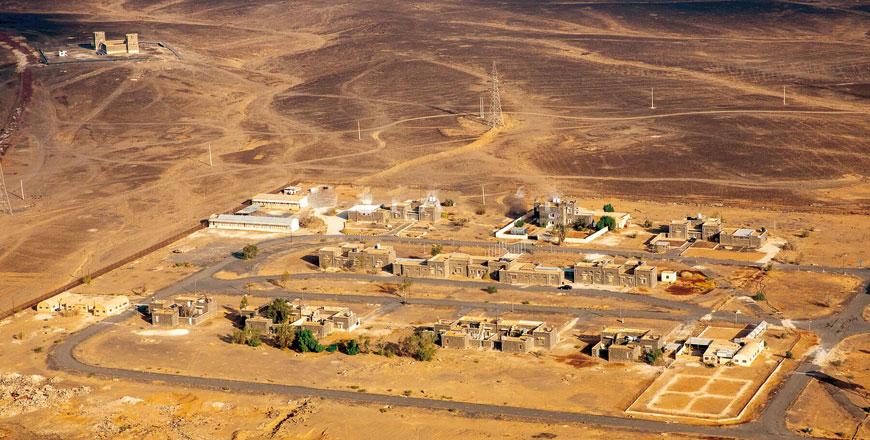You are here
CBRL digs into colonial archaeology: Case of H5 pumping station
By Sophie Constantin - Jul 20,2024 - Last updated at Jul 20,2024

H5 Oil station residential quarters (Photo courtesy of APAAME 2022)
AMMAN — The Council for British Research in the Levant (CBRL) hosted a lecture in Amman on colonial-industrial archaeology on Wednesday, presented by Shatha Mubaideen, a senior researcher and partnership officer for the CBRL.
The lecture focused on the first survey of the Kiruk-Haifa pipeline H5 pumping station, located in As-Safawi, Eastern Jordan, and constructed during the British Mandate. Researchers conducted a photographic survey of the H5 station and examined archival material from Britain. Following the research phase, a dissemination workshop and a roundtable discussion were held with the local community to gather insights for future research development, emphasising the role of archaeology in documenting, analysing, and preserving Jordan’s colonial-industrial heritage.
Mubaideen mentioned the increasing interest in industrial, colonial, and military archaeology in recent decades, noting the significant impact of oil discovery on the region’s geopolitics and colonial history. Despite the crucial role of oil extraction in Middle Eastern modern history, its industrial heritage has been relatively under-researched.
Mubaideen started by providing historical context: “Until 1918, Jordan was part of the Ottoman Empire and came under the British Mandate in 1920. In 1921, it became the Emirate of Transjordan, ruled by Emir Abdullah. British colonial administrators controlled Jordan’s financial, military, and foreign policy. During this period, Jordan saw significant development, including the construction of key transportation and industrial infrastructure. The Hashemite Kingdom of Jordan gained independence in 1946”.
She then discussed the characteristics of British colonial architecture, which was shaped by the Empire’s strategies and objectives. This style blended architectural elements from the home country and expressed power through buildings, museums, industrial projects, and educational facilities.
“One of the most significant projects in Transjordan was the construction of the Iraq Oil pipeline, starting from Kirkuk in Iraq, going to Tripoli in Lebanon, and Haifa in Palestine. Jordan hosted two pumping stations, H4 and H5, which transported oil from Kirkuk’s oil fields to the Mediterranean Sea and then to Europe. The operation was halted in 1948 due to the Arab-Israeli war”, she said, adding that the British persuaded the Iraqis to shut down the pipelines after losing control of the Haifa pipelines.
The petroleum pipeline agreement was established between the Iraq Petroleum Company (IPC) and the governments of the Emirate of Transjordan and Lebanon in 1931, later including Syria and Palestine in 1933. The agreement granted the company rights to operate the pipelines, utilise various transportation forms (land, water, or air) for the movement of employees and materials, in compliance with local laws.
“After the agreement’s expiration, project properties were to be transferred to the government. The IPC was also prohibited from using religious sites, cemeteries, archaeological and historical places for the project’s facilities”, she said, adding that the company was required to employ local workers as much as possible.
The infrastructure included a 24-hour communication system for pipeline construction and operation, featuring a landline network with emergency wireless installations and aircraft supporting communication infrastructure. The British Royal Air Force established landing strips, southeast of the pumping station, as part of the Cairo-Amman-Baghdad airmail route, one of the longest segments in the British Empire. The navigation aids, including regularly placed landing strips and ground installations like furrows and arrows, ensured safe navigation.
“The key components of the H5 station included more than 47 resilient steel and stone structures. The headquarters served as the employment office of Transjordan, housing representatives from various departments such as medical, engineering, and security”, Mubaideen said, noting that the central Service Unit was crucial for accommodating departmental representatives and providing various services, especially during emergencies.
The structures included amenities such as accommodation, laundry facilities, a bakery, food stores, cold storage, a dispensary, a sick room, and armoury facilities with two fortifications planned for the security department.
The residential quarter accommodated personnel, with two houses for superior personnel, and six cottages for others. The British Building Department also built a defensible police post on high ground for a detachment of the Arab legion, Transjordan’s police force. This model was replicated in other areas of Jordan.
The emergence of the town of As-Safawi is directly linked to the pipeline construction and the establishment of the H5 pumping station. The town began as a camp for workers during the construction of the station, and its name was “Arabised” to become Al-Jfayef.
Related Articles
AMMAN — British colonial architecture in Jordan was the focal point of a workshop held at the Council for British Research in the Levant (CB
AMMAN — Jordanian photographer Bashar Tabbah captivated the audience at the British Council for Research in the Levant (CBRL), with a “photo
AMMAN — The Hejaz Railway was “a monumental feat of engineering and a triumph of Islamic financing over Western capital, and the last desper

















